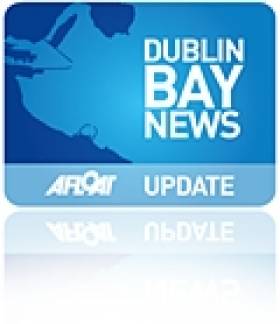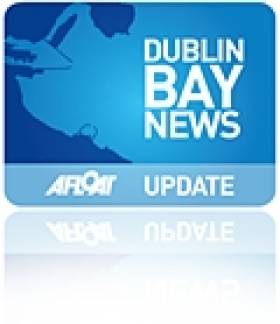Displaying items by tag: Sea Safari Tours
Dublin Port: As You’ve Never Seen It Before
On board the open-topped yellow tour-boat RIB, an audio commentary firstly informs you about the M.V. Cill Airne, built nearby in the old Liffey Dockyard, nearly fifty year ago. Discover why she was one of the last riveted built vessels in Europe, her days as liner-tender and the rich and famous who threaded her decks.
Heading downstream the former lightship Kittiwake is berthed opposite the O2 Arena. She was one of the last lightships to serve in Irish waters at the South Rock station off Co. Down. In complete contrast a ferris-wheel revolves in the background but no sooner the boat slips under the East-Link Toll-Lift bridge which opened in 1984.
On the other side of the bridge a small non-descript looking grey-hulled motorboat lies at anchor, on her bow is painted the figure 11. So what's the story here!...here's a glue: 'Don't pay the ferry man until you get to the other side!...
Past Poolbeg Marina, giant blue-gantries cranes of the Marine Terminal Ltd (MTL) are busy unloading from Karin Schepers, a containership previously reported on Afloat.ie. Look out for the ports 'graffiti', the work of crews who make their mark by painting the name of their ship and also the mural of the late Ronnie Drew of The Dubliners.
Opposite this terminal is the ports largest basin, Alexandra Basin, named after Queen Alexandra. Subject to port security, the tour may include entering the basin should there be a particular vessel of note.This also allows for views of the dock-gates of the Dublin Graving Dock, one of only three large ship-repair facilities on the island of Ireland. Neighbouring the graving dock is where the Liffey Dockyard once stood.
Before the tour passes the towering twin stacks of the former ESB Poolbeg electricity power station is tucked away Pigeon Harbour. Learn more about its hotel conveniently sited beside where packet-ships regularly plied, essentially the ferryport of its day. Its modern-day counterpart faces opposite on the north quays where up to 17 sailings daily operate on the Irish Sea.
Marvel at the length of the impressive Great South Wall, why was it called 'Great' and why was it built?... What can be revealed is that Captain William Bligh of "Mutiny of the Bounty" fame was a major figure in the project, when the wall was completed in 1795.
The commentary has many more fascinating facts, figures and the occasional anecdote told with typical Dublin wit. So if you live within 80km (50-mile) radius of the capital, then the chances that the shirt you wear, the breakfast cereal you ate and the car you drive, most likely came through Dublin Port as almost 75% of goods serve this hinterland.
More on Dublin Bay here
- Dublin Port
- River Lee
- Sea Safari Tours
- Poolbeg Marina
- River Liffey
- Ports and Shipping News
- ESB
- Karin Schepers
- EastLink bridge
- Dublin Port & River Liffey Tours
- Dublin ferryport
- MV Cill Airne
- ESB Poolbeg powerstation
- Alexandra Basin Dublin Port
- Liffey Dockyard
- Dublin Bay boat operator
- Marine Terminal Ltd
- MTL
Up Close and Personal: New Boat Tours of Dublin Port
In addition to cruising this stretch of the River Liffey alongside the 'Docklands' quarter, the tour RIB boat will pass downriver through the East-Link toll bridge where visitors will get closer views of the variety of vessels and calling cruise liners from other ports throughout the world.
There will be five daily tours beginning at 10.00am, 12.00pm, 2.00pm, 4.00pm and 6.00pm.Tickets cost €15.00 for adults, €12.50 for students and the charge for senior citizens and children is €10.00.
In addition Sea Safari operate a 'River Liffey' only tour, a Dublin Bay 'North' and 'South' tours which visit Howth Head, Baily Lighthouse, Ireland's Eye and to Dalkey Island and Killiney Bay, where both bay tours provide a chance to spot local marine wildlife of seals, porpoises and sea birds.
- Rib
- Dublin Port
- Dublin Docklands
- Howth Head
- marine wildlife
- Cruise Liners
- Sea Safari Tours
- Dalkey Island
- Port of Dublin
- River Liffey
- Ports and Shipping News
- EastLink
- EastLink Toll Bridge
- Dublin Port news
- Baily Lighthouse
- Killiney Bay
- Seabirds
- Port of Dublin news
- RIBcraft
- M.V. Cill Airne
- Dublin Port cruise liners
- North Quay Wall Dublin
- Dublin Bay tours
- Ireland's Eye
Dublin Bay Oil, Gas, Coal...and Waste-Water!
The work is part of a Dublin City Council project to evaluate an extension at the Ringsend plant where treated water will be released into the bay. The council are conducting detailed feasibility studies which will be examined for an Environmental Impact Assessment.
To date the project has involved two other rigs, the Aran 250 and the larger Excalibur which remains in the bay. The barges will be towed to 20 pre-determined bore-hole locations in the bay where the jack-up rig barges operate 'legs' to sit on the seabed which enables a steady working platform. The rigs are operating on a continuous basis in an area covering most of Dublin Bay and close to the Burford Bank on the eastern fringes.
In addition a buoy will be positioned 300-metres of the barge during drill operations, which is expected to take approximately one week for each drill. For information on the location of the bore-holes, they can viewed from the Dublin Port website by clicking HERE The project is expected to be completed in late Spring.
Several support craft are engaged in the project that recently included the Seabed Worker, a 3,923 gross tonnes Norwegian anchor-handling tug supply vessel (AHTS) the tugs Multratug 7, MTS Valiant and Trojan and the RIB-craft sisters, Brian Boru and James Joyce which are on standby duties. Like the Trojan, the 12-seater RIBS are based at the Poolbeg Yacht Club Marina where in the tourist season the craft provide excursions in Dublin Bay for Sea Safari Tours. In October the project also required the services of the yellow-hulled catamaran, Xplorer to carry out a bathymetric survey of Dublin Bay. The larger tugs and rigs are based opposite in Alexandra Basin / Ocean Pier.
The largest drill-rig working to date on the project, the Excalibur arrived under the tow of the Multratug 7 on a misty morning on Christmas Day. Due to the weather conditions the red-hulled craft slipped quietly into the port. Several days later the imposing looking craft re-emerged with its six-towering jack-up 'sea-legs' that jutted skywards into an otherwise horizontal expanse of Dublin Bay.
The sight of the rig has presented many onlookers to mistakenly believe the drilling was for oil!...Not so but the assumption is not surprising given the reports last year of an oil-field discovery named the Dalkey Island Prospect. The name for the oil-field was referred to Dalkey, as the coastal suburb on the southern shores is the nearest landfall to the exploratory well sites at the Kish Bank Basin.
In fact this kind of exploratory activity was again to confuse residents throughout the bay when the drill-ship, Fugro Synergy was offshore at the Kish Bank between December 2009 and early Spring of 2010. Though on this occasion the search was not for oil but coal!
During this period the 5,200 tonnes vessel equipped with a drill-tower, seemed to be a near permanent feature on the horizon. A series of drill-wells up to 3,500-metres were conducted when the 2009 built ship was contracted to Irish based VP Power Ltd, to determine the commercial viability of extracting coal from the sea for generating electricity. The Underground Coal Gasification (UCG) project is a process where coal is heated in underwater rock reservoirs to extract gas, essentially converting gas-from-coal energy. Otherwise this method is commonly referred to as a 'clean' technology.
In addition to last year's search for deposits of large coal seams under the seabed, there was reports of a significant natural resource in the form of oil!... when several exploratory blocks again in the Kish Bank Basin were surveyed. The company behind this venture, Provident Resources, another Irish based exploration company, conducted initial oil surveys using air-born craft and as such no actual drill-based ships or rigs were used. Though should any oil flow, such an operation would be required.
Incidentally the Excalibur is designed also to perform offshore wind turbine installation work and is equipped with a 250-ton crane to hoist the wind-farm components. The vessel is operated by Fugro Seacore, a subsidiary of the Dutch parent company, Fugro, which also managed the drill-ship Fugro Synergy.
Drilling of Test Boreholes in Dublin Bay
The barge is contracted to Dublin City Council for the drilling of test boreholes in the approaches to and within Dublin Bay in relation to the Ringsend Wastewater Treatment Plant. Both jack-up barges 'Aran 250' and 'Excalibur' will be operating on a 24-hour / 7 days per week basis.
In attendence Sea Safari Tours RIB 'James Joyce', which normally operates as a tourist-sightseeing craft will act as a stanby boat during the rig operations. In addition a buoy will be positioned 300-metres of the barge during drill operations, which is expected to take approximately one week for each drill.
The project will also see the tug, Trojan providing supplies and to tow the jack-up rigs between locations in Dublin Bay. Both the James Joyce and the Trojan will be based out of the Poolbeg Marina, in the centre of the port.
Since the start of October, the project has also required the services of the yellow-hulled catamaran, Xplorer to carry out a bathymetric survey of Dublin Bay.
For further detailed information, please consult Notices to Mariners (No. 14 and 15) listed on the Dublin Port Company website by logging onto this link: http://www.dublinport.ie/information-centre/notice-to-mariners/
In addition to www.dublincity.ie
































































